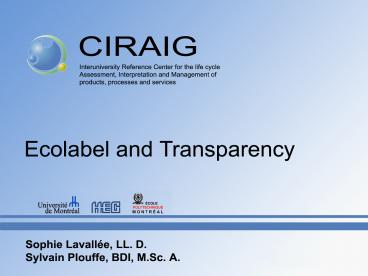Contents - PowerPoint PPT Presentation
1 / 24
Title:
Contents
Description:
Protection of the environment (Natural environment) ... Build consumer awareness of environmental issues (User) ... Organizational and legal aspects ... – PowerPoint PPT presentation
Number of Views:35
Avg rating:3.0/5.0
Title: Contents
1
(No Transcript)
2
Contents
- Introduction
- ISO 14024 Environmental labels and declarations
(Type I) - ISO 14021 Self-declared environmental claims
(Type II) - ISO 14025 Environmental labels and declarations
(Type III) - Specific goals for each Type
- Critic of each Type
- Possible improvement in ecolabelling
- Question period
3
Goal of labels and declarations (ISO 14020)
- Through communication of verifiable and accurate
information, that is not misleading, on
environmental aspects of products and services,
to encourage the demand for and supply of those
products and services that cause less stress on
the environment, thereby stimulating the
potential for market-driven continuous
environmental improvement
4
Goals
- Protection of the environment (Natural
environment) - Encourage environmentally sound innovations
(Enterprises) - Build consumer awareness of environmental issues
(User)
5
Environmental labels and declarations
- ISO 14024 Environmental labels and declarations
- (Type I environmental labelling)
- ISO 14021 Self-declared environmental claims
- (Type II environmental labelling)
- ISO 14025 Environmental labels and declarations
- (Type III environmental declarations)
6
Type I Label specific goal
- Identify overall environmental preference of a
product or service within a particular
product/service category based on life cycle
considerations.
7
Type I Label
- Voluntary
- Delivered by a third party
- Evaluation criteria are scientific, complete and
transparent - Regional, national or international application
Ecolabel Type I ISO14024
8
Ecolabelling process (Type I)
- Setting criteria
- Certification
Ecolabel Type I ISO14024
9
Setting criteria
- Product category
- Life cycle considerations
Ecolabel Type I ISO14024
10
Certification
- Compliance to criteria
- Agreement
Ecolabel Type I ISO14024
11
In practice
- Life cycle and criteria (Type of evaluation used)
- Organizational and legal aspects (Example The
Canadian Environmental Choice Program managed by
Terra Choice.)
Ecolabel Type I ISO14024
12
Evaluation used in programs
1- Qualitative LCA Australia, Canada, Japan, New
Zealand, United States, Italy. 2- Qualitative as
well as quantitative considerations in some life
cycle stages Austria, Germany, Sweden, Norway,
Finland, Iceland, Netherlands, United
kingdom. 3- Quantitative LCA France, Denmark.
Ecolabel Type I ISO14024
13
Example
- Environmental Choice Canada
- The criteria of 55 products were determined by
the initiative of Terra Choice with its
Consultative Committee. - The criteria of 85 other categories were given
following the request of a producer. Terra Choice
left with the producer the care to prove in what
his product is less damaging than other similar
products. - Result
- Delivery of an ecolabel for a product which, at a
given stage of its life cycle, is 20 less
damaging than other products of its category.
Ecolabel Type I ISO14024
14
Organizational and legal aspects
- Because most of the programs are managed by
private organizations, there is a lack of
government involvement and regulation. The
Canadian Environment Choice Program is a good
example of this situation. - In North America, ecolabelling programs rely on
the private sector. This reality has an impact in
the selection of products and ecolabeling
criteria as well as on the methodology used.
Ecolabel Type I ISO14024
15
Conclusion on Type I
- The determination and the weighting of the
criteria from one program to another rest on
different methodologies and practices. - The mode of definition of the criteria of
ecolabelling for these various programs
translates into the preeminence of a competing
logic over an ecological logic.
Ecolabel Type I ISO14024
16
Type II Specific goals
- Standardize the use of self-declared
environmental claims - More specific claims
- Promote environmental improvements
- Minimize imprecise claims
- Reduce confusion
- Facilitate international commerce
- Make well informed choices
Ecolabel Type II ISO14021
17
Frequently used terms in environmental claims
- Compostable
- Degradable
- Designed for disassembly
- Extended life product
- Recovery energy
- Recyclable
- Recycled content, etc.
Ecolabel Type II ISO14021
18
Danger with self-declared environmental claims
- Claims are made according to a specific life
cycle phase - - The phases where the impact is more important
can be ignored. Consequently, the labeled product
is not necessarily the one with the less impact.
Ecolabel Type II ISO14021
19
Environmental Declarations Type III
- Same general objectives as 14020
- The difference is on the methodological aspects
- - quantified environmental information on
product in type III declarations must be based on
procedures and results issuing from a life cycle
analysis in conformity with ISO 14040 standards.
Ecolabel Type III ISO14025
20
Use of Type III declarations
- Give environmental information on a product
- Compare products
Ecolabel Type III ISO14025
21
Main difficulties in Type III
- Availability of data bases
- Specific methodology and data for local and
regional impacts - Accessibility for SME
Ecolabel Type III ISO14025
22
Objectives of labelling
23
Improvements
- Evaluation (SLCA with single score indicator)
- Governmental implication
- Legislative framework
- Banned on self-declared claims
24
Improvement (difficulties)
- May be expensive for the Government at the
beginning, but this expenditure must be
considered as a long term investment. - The possible and future responsibility for the
Government in granting Ecolabel to products which
could prove to be harmful in the future (e.g. of
asbestos). - Risk of favoritism towards certain companies.

























![Top Content Writing Agencies in India 2022 [Updated 2022] PowerPoint PPT Presentation](https://s3.amazonaws.com/images.powershow.com/9707624.th0.jpg?_=20220110052)





